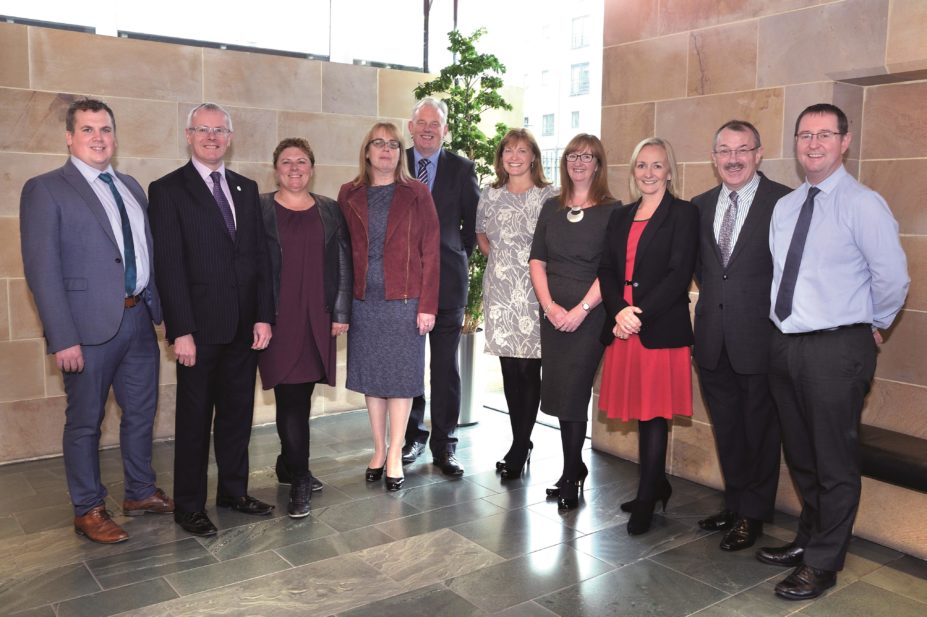
Courtesy of the Royal Pharmaceutical Society
The first Scottish Pharmacy Board (SPB) meeting of 2017 was held on 18 January 2017 at Holyrood House in Edinburgh.
The meeting began with news that board member Alan Glauch would be stepping down from his position. John McAnaw, chair of the SPB, passed on a message from Glauch that it had been “a pleasure and an honour to be part of a team that has achieved so much on behalf of the profession”.
This led to discussions about the national pharmacy board elections for 2017, when four members of the SPB — Ewan Black; Glauch; Ailsa Power and Andrea Smith — will be coming to the end of their elected terms. Board members emphasised how they were keen to encourage new people to think about standing, particularly younger members.
Martin Astbury, president of the Royal Pharmaceutical Society (RPS), provided an update on the governance of the Society, which has recently been reviewed. During his update, he reassured the SPB that the views of all of the boards had been taken into account in the governance review.
John Cromarty expressed concerns that the number of Assembly members from each country remains in favour of England and that each country should be equally represented and be able to submit the same number of votes. He also argued that there should be a formal cap on the number of terms to be served by the RPS president, country board chairs and RPS treasurer to ensure frequent rotation of each and that the Assembly should be leaner to keep costs down.
Astbury responded by saying that feedback from all three boards had been taken into account but that other recommendations have been made to save more money than would be saved by reducing the size of the Assembly.
Alex MacKinnon, director for Scotland, highlighted that discussions were ongoing and any changes will remain part of the RPS’s evolution into a royal college. Helen Gordon, chief executive of the RPS, said that the audit committee needs to focus on getting the right skills on the Assembly in order to provide appropriate governance, rather than focusing on proportional representation.
The board also discussed the position of the lay member of the Assembly. It was suggested that the current lay representative, Hamish Wilson, may not put his name forward for the 2017–2019 appointment. Board members were encouraged to put forward any potential candidates before 17 March 2017. It was agreed that a lay member with more of a public perspective and less empathy towards pharmacy would help provide a different angle to discussions.
In the director’s update, MacKinnon explained that Norman Lannigan, head of the pharmacy and prescribing support unit in NHS Greater Glasgow and Clyde and lead of the Evaluation of Automated Technology group set up as part of the Scottish government’s Prescription for Excellence (PforE) programme, is exploring different models of automation including installing ‘hub-and-spoke’ dispensing systems at 21 sites in Scotland. The aim is to evaluate what technology can provide in terms of releasing time for care.
MacKinnon also said that there had been a number of meetings between the schools of pharmacy, Community Pharmacy Scotland, the Scottish government, the RPS and others relating to the four plus one-year degree and the five-year integrated degree.
MacKinnon said it was his impression that Scotland is moving towards the five-year integrated degree, but that it would take over a decade to get to that. At this point, Anne Boyter, member of the SPB, said that there is a disconnection between health services and education that needs to be addressed.
Next, MacKinnon talked further about the PforE programme, an update of which is expected to be published imminently. New SPB member Johnathan Laird said that he hoped that any ‘refresh’ of PforE will be applied equitably as opportunities for pharmacy go beyond pharmacists in GP surgeries, where a lot of money is currently going. MacKinnon said that the SPB needs to challenge the Scottish health minister on resources and ensure that PforE takes into account recommendations made by the RPS. He suggested that someone from government attends SPB meetings on a regular basis to provide updates.
Much of the meeting was focused on acknowledging the work carried out by RPS Scotland during 2016 and finalising the 2017 business plan. McAnaw commended the team on the work carried out last year, highlighting that all of the business plan actions for the year had been achieved. He commented that this was due to the efficiency and leadership of the RPS Scotland and executive teams.
Carrying on from work started in 2016, RPS Scotland will continue to deliver its quality improvement roadshows to help empower pharmacists in Scotland, as well as continuing to work closely with NHS Education for Scotland, and promoting the role of pharmacists in managing long-term conditions.
A fundamental part of the 2017 plan for RPS Scotland will be around local engagement and developing a new model for local practice forums, with quality events and a digital offering to encourage higher member engagement. The board agreed that the success of this will be dependent on the SPB engaging with members at a local level. MacKinnon also highlighted that further work needs to be done to increase awareness of the RPS among members of the Scottish Parliament (MSPs) — a survey carried out in 2016 highlighted that many MSPs were not aware of the RPS.
RPS Scotland is also hoping to establish an innovators forum to bring together experts to inform policy and work streams and to encourage more pharmacists to work with the RPS. Other priorities agreed for the coming year include promoting science in practice through the RPS’s online self-accreditation tool Research Ready; carrying on the rebalancing work around supervision; continuing work on the Falsified Medicines Directive; and hosting a two-day national seminar around professional engagement development.
Agreed targets for 2017 include having 57% of practising pharmacists in Scotland become members of the RPS and for 95–97% of preregistration students to move toward full membership.
All SPB members agreed to approve the business plan for 2017.
Next, Leaghann Watson, who has been responsible for local research engagement activities at RPS Scotland since August 2016, gave an overview of the Research Ready programme in Scotland. Three pharmacies in Scotland have been accredited as Research Ready so far. Through one-to-one surgeries, research and evaluation hub networks and by developing pharmacy researchers, it is hoped that ten pharmacies will be accredited by the end of 2017.
Finally, the announcement was made that MacKinnon will be stepping into the role of interim chief executive after Helen Gordon’s departure on 22 February 2017 and that Aileen Bryson, practice and policy lead at RPS Scotland, will be taking on the role of director for Scotland during that period.
The next Scottish Pharmacy Board meeting will be held on 27 April 2017.
References

